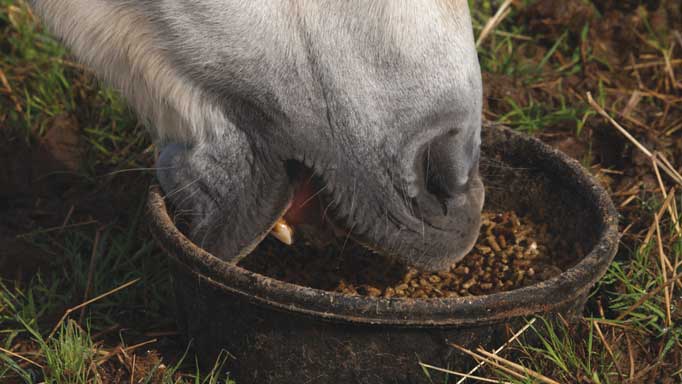While there are some inherent changes to an older horse’s nutrient needs, further complicating the situation are changes to the horse’s teeth and behaviour that may affect their eating ability and feed intake.
The ideal weight – is leaner actually better?
One of the best ways to ensure your older horse is doing well nutritionally is to monitor his body condition score, or how much fat coverage he has. If his nutritional intake isn’t sufficient, particularly in terms of calories or energy, he will lose weight, and this will result in visible ribs or shoulder blades. However, an “ideal” body condition score for an older horse is difficult to recommend. Some older horses actually do a little better on the lean end of the scale, with some ribs visible, no less than a 4 on the 1-9 Henneke scale (see “Henneke Body Condition Scoring” in the Nov. 2012 issue), because any additional weight (fat) may put additional strain on older joints. However, other older horses do better a little on the plumper side (ideally a 6, but no more than a 7), because then if there is a problem and they lose weight, they have a bit of a buffer.
An excellent diet is limited by what a horse will actually consume. Older horses may be at the lower end of the pecking order, and if feed is only offered in group format (round bales, feeders), they may not be able to consume as much as needed. In addition, age-related arthritis or other conditions may limit the horse’s movement, affecting mobility in the pasture and flexibility around a feeder. Older horses should be fed individually where possible – particularly any grain meals – and in feeders that are comfortable for them to eat out of if they have arthritis issues.
The importance of dental health
Equine teeth continuously erupt throughout horses’ lives, but are worn down through the grinding action of chewing. Older horses may not have much tooth or enamel left, or teeth may fall out, and they become at risk for dental problems such as gum disease and cheek abscesses. If the molars and premolars are offset by abnormal wear or tooth loss, the grinding surface is uneven, affecting the horse’s ability to chew properly. Therefore, even if a perfectly balanced diet is offered, an older horse may not be able to chew and digest it efficiently.
Dental problems may also put the horse at risk for colic, as larger particles of hay may not be broken down sufficiently and may result in blockages and impaction colic. Similarly, an older horse may be more prone to choke. Senior equines should have regular annual dental check-ups, and may benefit from more frequent inspections. If the horse is observed “quidding” (dropping compacted masses of hay and saliva) while chewing, and this behavior is combined with weight loss or bad breath, a veterinarian should be consulted.
Changes to Diet
In terms of changes to nutrient requirements, there have been a few studies that have identified some differences in nutrient digestion in older horses. If a horse cannot digest a nutrient or feed type as well, increased amounts of that nutrient, or different sources, may be offered to increase digestibility.
Older horses appear to have decreased ability to digest protein and phosphorus. These nutrients should therefore be included in an older horse’s diet in slightly elevated amounts, and from higher-quality ingredients. Most feeds designed for older horses do contain slightly elevated amounts of protein (CP ~12-14%) and phosphorus (~0.6%), and the protein is from sources such as soybean meal. Research also suggested that older horses have lower vitamin C (ascorbic acid) status, thus suggesting either insufficient synthesis (horses can usually synthesize their own, so there isn’t a dietary need for additional vitamin C) or increased use (because vitamin C is an antioxidant). Therefore, manufactured diets for older horses also tend to have vitamin C added.
Many seniors do well on a diet of good-quality hay offered free choice and a commercially manufactured grain mix (concentrate) that has been formulated for older equines. If a horse’s teeth aren’t ideal, they may do better on alfalfa hay, because it tends to be “softer”, although some older horses may have kidney or liver issues and may not be able to deal with the extra protein. Chopping the hay or offering hay cubes are excellent options for older horses, and the cubes may be soaked to be more suitable for their older teeth.
Other good-quality fibre sources include beet pulp and rice bran, and these should be fed soaked. Most commercial feeds for older horses can also be soaked. The addition of vegetable oil to the slurry is an excellent way to increase the calories going into your horse. You may also consider the addition of oral joint supplements or probiotics, although they may or may not be effective.
Cereal grains (oats, corn, barley) can be fed to older horses instead of commercial mixes, provided they are suitably processed and supplemented with good-quality protein sources and sufficient vitamins and minerals. It is not uncommon for older horses to need very large concentrate meals, particularly as their teeth are lost and the amount of hay they can handle (even as hay cubes) decreases. If large amounts of concentrates are required, it is suggested to feed them in several small meals per day (upwards of 4-5) because older horses often eat more slowly. In fact, some horses may do well with food in front of them at all times, although the bin should be cleaned daily.
Discuss your older horse’s needs with your veterinarian, and work with an equine nutritionist to ensure his diet is suitable and capable of meeting his nutritional demands.

